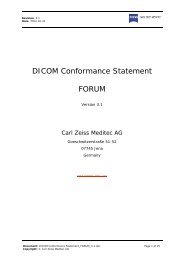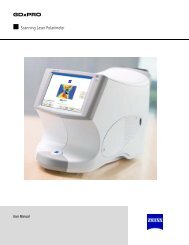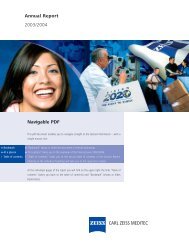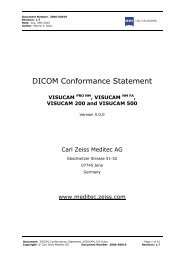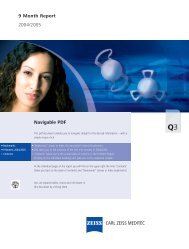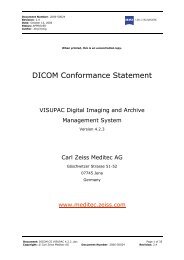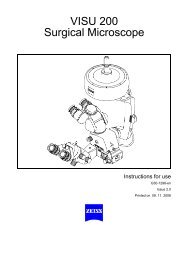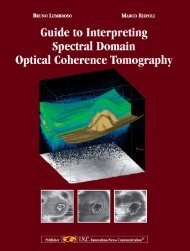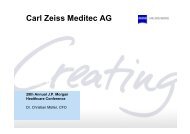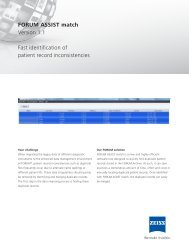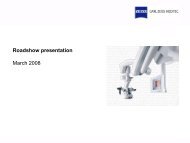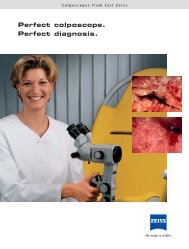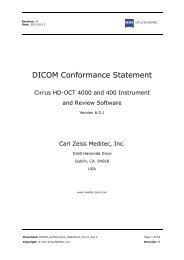Download - Carl Zeiss Meditec AG
Download - Carl Zeiss Meditec AG
Download - Carl Zeiss Meditec AG
You also want an ePaper? Increase the reach of your titles
YUMPU automatically turns print PDFs into web optimized ePapers that Google loves.
surgeons assume that introducing a new technology may<br />
compromise the safety and efficacy of a well-established<br />
procedure. However, we experienced the opposite. In fact,<br />
our previous results with the microkeratome—even in our<br />
best year—are inferior to our results with the femtosecond<br />
laser—even in the early years of its inception in 2008.<br />
We expected there may be a dip in postoperative results<br />
when we started performing ReLEx. Because we have such<br />
an extensive database of surgical results, it has been very<br />
easy for us to compare results with ReLEx and LASIK. Not<br />
only have our ReLEx flex results matched our femtosecond<br />
LASIK results, but this has been achieved without any specific<br />
nomogram adjustment to optimize our outcomes.<br />
We have also performed a study in 1,500 eyes that<br />
underwent myopic LASIK and 100 eyes that underwent<br />
ReLEx for myopia correction. We matched the eyes for<br />
their preoperative level of myopic correction and found<br />
that the visual outcomes in both groups were similar. The<br />
other thing that we were able to show in this study is that<br />
not only was the safety and efficacy equivalent in these<br />
two groups but when we looked at the eyes that had<br />
between -5.00 and -10.00 D of myopia preoperatively, the<br />
ReLEx eyes had better predictability than the LASIK eyes.<br />
TRANSITIONING TO ReLEx smile<br />
Today, we have transitioned from ReLEx flex to ReLEx<br />
smile. This flapless version of the ReLEx technique is<br />
even less invasive than ReLEx flex. Although we have a<br />
much smaller cohort of results to draw from, we have<br />
compared our newest ReLEx smile results to our results<br />
with not only femtosecond LASIK but also with ReLEx<br />
flex. What we are seeing is that ReLEx smile increases<br />
upon the safety and efficacy that we were able to<br />
achieve with ReLEx flex. Additionally, a much higher<br />
number of patients achieve 20/16 vision than compared<br />
with our femtosecond LASIK patients.<br />
We believe that the reason for the improvement in<br />
results between ReLEx flex and ReLEx smile has to do with<br />
the elimination of flap creation. We have observed that for<br />
higher corrections (between -5.00 and -10.00 D) the flap<br />
induces a significant amount of aberrations into the optical<br />
system. I like to use the following analogy to explain<br />
this phenomenon: The anterior cornea is like a suspension<br />
bridge. Therefore, as you cut vertically across the suspension<br />
bridge (ie, flap), you initiate a collapse in the structure.<br />
With ReLEx smile, however, there is only a small vertical<br />
cut and therefore minimal collapse or stromal damage.<br />
In our studies, there were less induced aberrations<br />
after ReLEx flex than after femtosecond LASIK. This year,<br />
we are conducting a follow-up study with ReLEx smile<br />
that will assess induced aberrations.<br />
TAKE A CHANCE ON A NEW TREATMENT<br />
LASIK is perhaps the most well-known, well-documented<br />
elective procedure in the world. It has helped<br />
ReLEx smile: Flapless. All-femto. Single-step.<br />
millions of people worldwide achieve excellent visual<br />
quality without the need for spectacles. However, as<br />
with any procedure, there are disadvantages. In 2009,<br />
Solomon et al 3 published a study showing that approximately<br />
4% to 5% of patients were unhappy after LASIK.<br />
This is a very small percentage; however, if given the<br />
sheer volume of patients who have undergone LASIK,<br />
this equates to a significant number of unhappy<br />
patients. The most common complaints are dry eye<br />
syndrome, problems with night vision or glare, regression,<br />
and complications during flap formation or traumatic<br />
dislocation postoperatively.<br />
Therefore, when we heard about the flapless, minimally<br />
invasive ReLEx smile procedure about 3 or 4 years<br />
ago, we considered switching to this treatment. Because<br />
the cornea is not cut all the way around, as it is for LASIK<br />
flap creation, biomechanical stability should improve,<br />
which should translate into a reduction of the side<br />
effects of LASIK, including post-LASIK ectasia.<br />
Taking a chance on a new treatment is worthwhile if<br />
it can provide our patients with a safer surgery that is<br />
just as effective, if not more effective, than other wellestablished<br />
treatments. I am pleased with the results we<br />
have had with ReLEx smile thus far, and I envision results<br />
continuing to improve as the treatment matures.<br />
At this time, however, an enhancement after ReLEx<br />
smile is challenging. <strong>Carl</strong> <strong>Zeiss</strong> <strong>Meditec</strong> is working on<br />
solving this issue. If regression occurs, one option is to<br />
perform surface ablation. But because ReLEx smile uses a<br />
lot less energy and there is maintenance of corneal integrity,<br />
regression is not as common as it is after LASIK.<br />
CONCLUSION<br />
ReLEx smile provides surgeons the advantages of LASIK<br />
while avoiding the potential side effects related to flap<br />
creation. Biomechanical stability is relatively stronger<br />
after ReLEx smile compared with LASIK, making wound<br />
healing faster after ReLEx smile. Additionally, there is no<br />
surface dryness on the tear break-up time after ReLEx.<br />
This procedure certainly has the potential to overtake<br />
LASIK as the procedure of choice for most patients.<br />
Jodhbir S. Mehta, MD, is Associate Professor<br />
and Co-Head of the Corneal and External<br />
Disease Service, is a Consultant at the Refractive<br />
Service Singapore National Eye Centre, and is<br />
Associate Professor at DUKE-NUS and YLL,<br />
School of Medicine NUS. Dr. Mehta did not provide financial<br />
disclosure information. He may be reached at e-mail: jodmehta@gmail.com.<br />
1. Riau AK, Angunawela RI, Chaurasia SS, et al. Early corneal wound healing and inflammatory<br />
responses after refractive lenticule extraction (ReLEx). IOVS. 2011;52(9):6213-6221.<br />
2. Ang M, Chaurasia SS, Angunawela RI, et al. Femtosecond lenticule extraction (FLEx):<br />
Clinical results, interface evaluation, and intraocular pressure variation. IOVS. 2012;53(4).<br />
3. Solomon KD, de Castro F, Sandoval H, et al. LASIK world literature review; Quality of life<br />
and patient satisfaction. Ophthalmology. 2009;116(4):691-701.<br />
OCTOBER 2012 SUPPLEMENT TO CATARACT & REFRACTIVE SURGERY TODAY EUROPE 9



